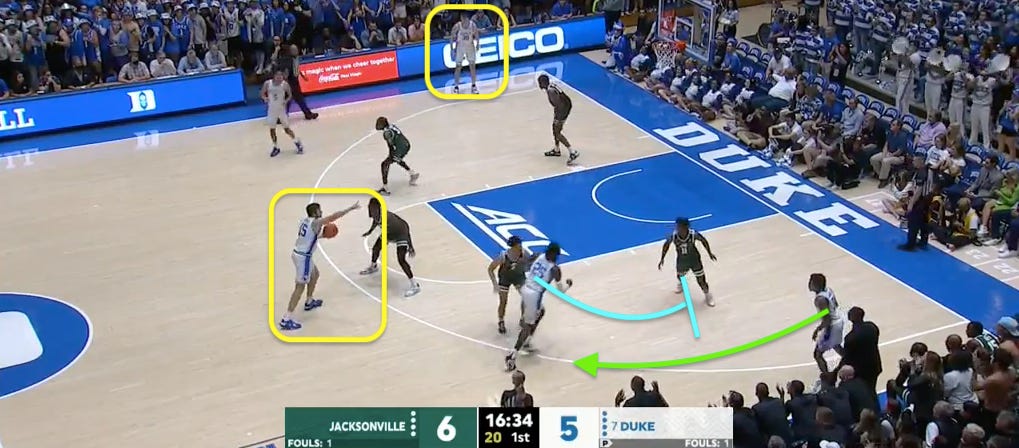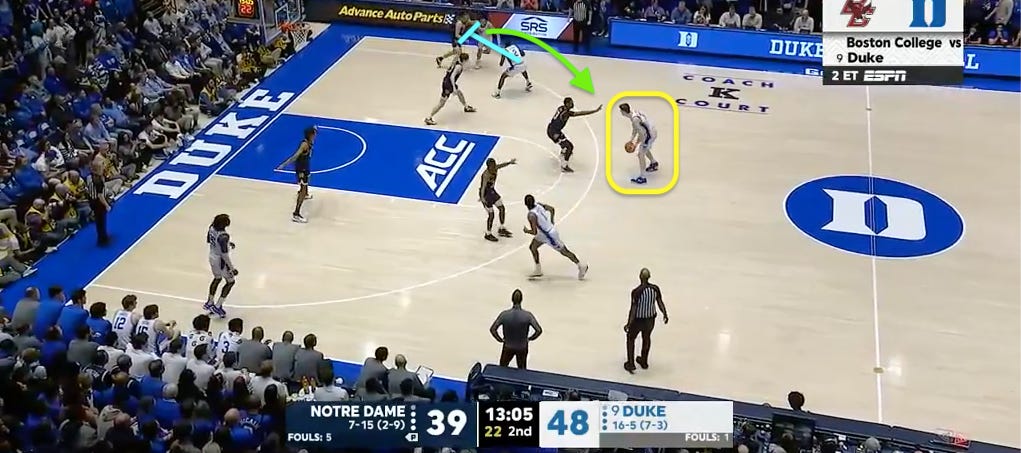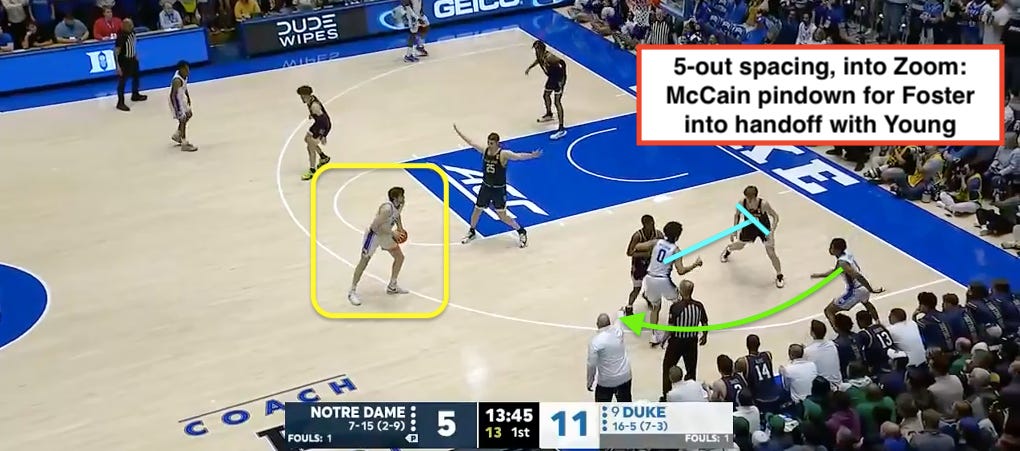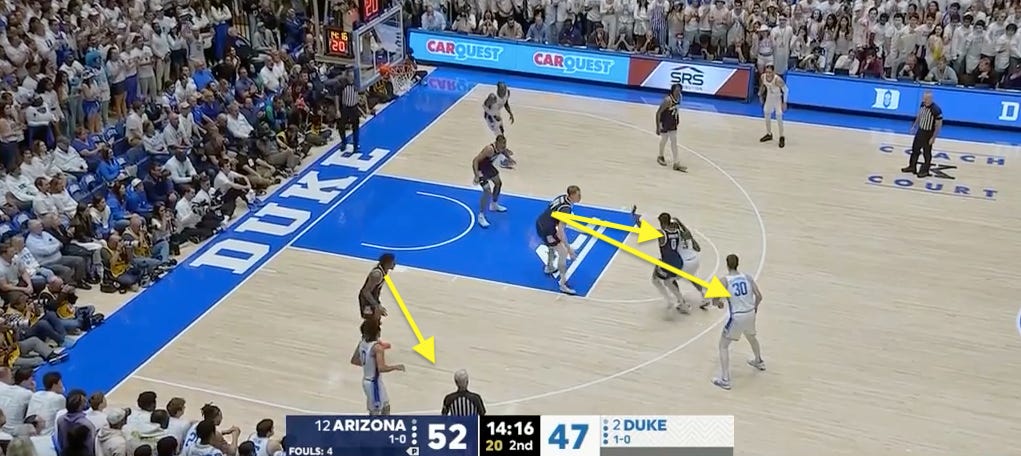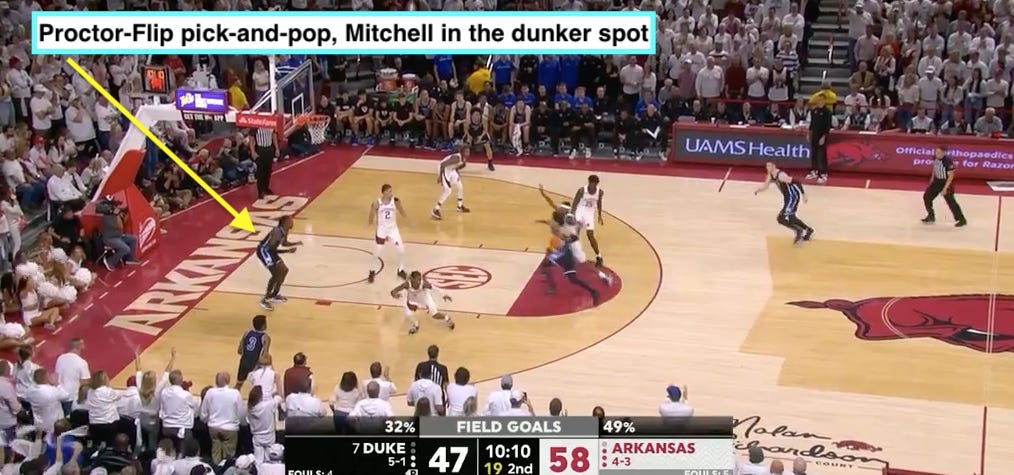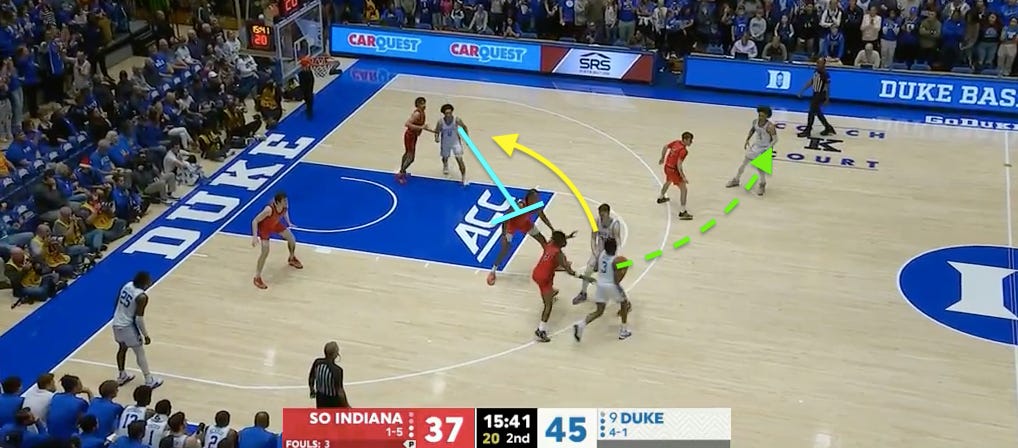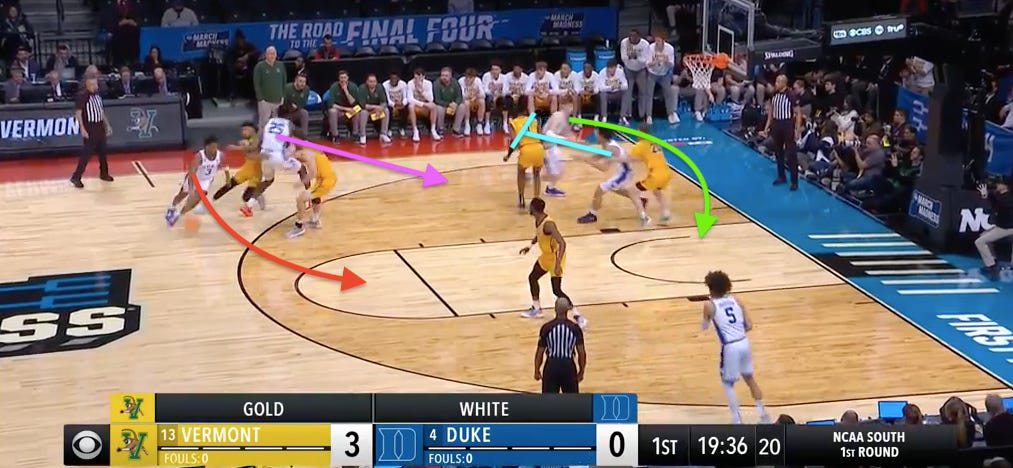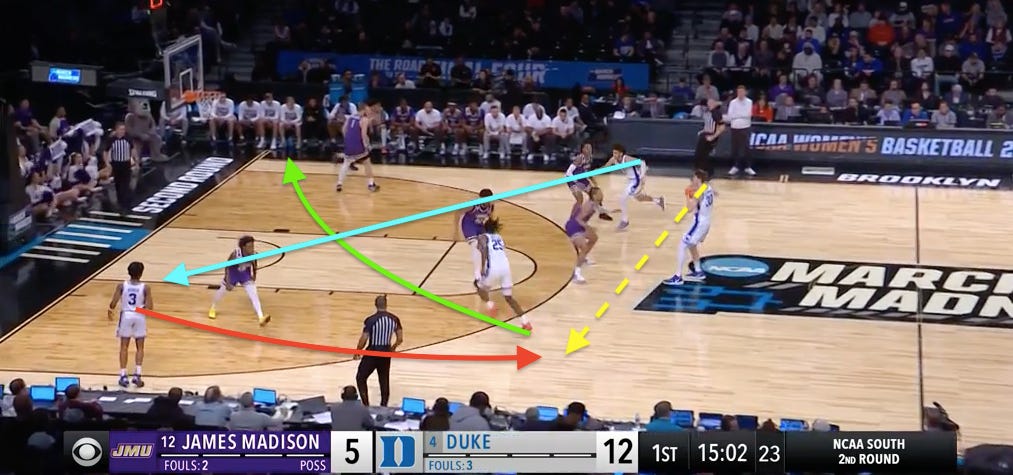Zoom Call: Inside Duke's 5-Out Offense
Detailing Duke's go-to 5-out actions and reads against different coverages
We’re well into the 5-out revolution in college basketball. For years now, teams have implemented 5-out schemes on offense, designed to put a premium on spacing and integrated playmaking.
Playing 5-out as a system or running 5-out sets doesn’t necessarily mean playing lineups that feature five shooters, although that helps, nor does it means running an offense built to only chuck 3s. By opening up the floor, 5-out offenses can take advantage of the added space and use that to drive the ball. Those downhill drives create all kinds of good things: layups, shooting fouls at the rim, kick-out 3s and cut finishes. Essentially, the best types of offensive outcomes.
Under Jon Scheyer, Duke has showcased plenty of 5-out looks. In fact, here’s one of the very first possessions of the Scheyer era: 5-out with Ryan Young initiating in the middle of the floor.
Different teams can have all different kinds of verbiage to describe these 5-out sets. Two of the more popular descriptors are “Delay” or “Open”, the latter of which seems to be used by Duke. (Often, when the Devils runs these sets, Scheyer signals by stretching his hands apart, like he’s opening up a big bag of chips.)
During this two-year stretch, Kyle Filipowski was the lynchpin of Duke’s 5-out. While playing primarily as the 4 in his freshman season, Flip was skilled enough to play off ball in these setups — in the corner or on the wing — as Dereck Lively or Young worked the middle.
On this possession, Jeremy Roach comes off a brush screen from Mark Mitchell and right into the pitch screen-roll with Young, which results in a paint 2 for Roach, although he misses a kick-out to a wide-open Tyrese Proctor.
When Filipowski returned for his sophomore year, and the Blue Devils didn’t land a center in the transfer portal, it seemed obvious that Scheyer and his staff would tailor a 5-out offense with Flip as a 6-foot-10 playmaking hub, surrounded by high-level guard play and the slashing/cutting of Mark Mitchell.
Duke played a lot of 5-out last season, which could flow into a variety of sets and actions: Flip handoff initiation, Flip cuts/post-ups, movement sets for Jared McCain, playmaking opportunities for Caleb Foster and Proctor, and the patented empty-side two-man game of Roach and Filipowski.
Here vs. Boston College: Mitchell cuts through on a 45 degree angle, which opens the left side of the floor for Roach and Flip. Quinten Post hedges the screen and Flip is open on the dive.
Of course, Flip and McCain developed nice chemistry in this action as well. Here’s McCain making the empty-side read to Flip on the dive against JMU in the NCAA Tournament.
It’s hard to argue with the results; Duke’s offense ranked Top 10 nationally in adjusted efficiency, while a landing inside the Top 35 of several key metrics: effective shooting (54.6 eFG%), TOV rate (14.4%) and 3-point percentage (37.7 3P%).
Despite moments of brilliance, Duke’s offense couldn’t sustain its top gear. For this team to hit its lofty preseason expectations, the Devils likely required a Top 5 offense, one that could threaten with dribble/pass/shoot skill from all five positions. With Mitchell going through a prolonged shooting slump, Duke never quite unlocked 5-out nirvana.
(The larger issues centered around the defense, which was good-not-great, and never really quite found its base.)
Lineups with Flip, three guards and TJ Power didn’t have enough two-way versatility with Power’s defensive limitations. Four-guard lineups, including those with Jaylen Blakes as a 6-foot-1 power forward, were positive in a pinch. During the Hofstra win — playing without the injured Proctor — Duke ran great 5-out offense with its 4-guard lineups, featuring plenty of inverted screening actions for Flip.
Overall, Duke was +7 in 40 minutes with Filipowski and four guards on the floor together, per CBB Analytics. Here’s a wonderful after-timeout (ATO) play call vs. Syracuse. Flip lifts to the top of the key and fakes the handoff to Foster, Roach cuts backdoor and kicks out to an open McCain after the bobble.
However, those groupings didn’t have enough size/length to sustain on defense. The Blue Devils needed Apex Mitchell to hit their two-way ceiling.
Duke’s roster for the 2024-25 season may not have Flip’s middle-of-the-floor skill and passing, but there’s all kinds of talent and quick-processing ability throughout the lineup. 5-out should continue to be an important piece of the puzzle.
Here are some concepts to keep an eye on, starting with “Zoom” action.
Zoom
Zoom (or “Chicago”) action is a pindown into a dribble-handoff (DHO) for an off-ball player. In 5-out looks, this off-ball player usually starts in the right of left corner.
On this possession, Foster begins in the right corner. McCain sets the down screen and Foster comes off into the handoff with Young. Foster turns the corner and attacks the space with Notre Dame in drop coverage.
More from the matchup vs. Notre Dame in Durham: it’s another 5-out Zoom play. This time, Flip and Proctor connect on the Zoom action — with Flip doing a nice job rolling and sealing deep in the paint for a Proctor layup.
Now, here’s the same 5-out Zoom setup vs. Wake Forest: Andrew Carr is in drop and Roach gets downhill for a finish at the rim.
Going back to the 2022-23 season, it’s more 5-out Zoom action at Boston College: Flip sets the pindown for Dariq Whitehead, who runs into the handoff with Young. Post is in drop coverage on this possession. Whitehead could look for the midrange jumper off the DHO, but he instead dumps it to Young and the post and relocates for a kick-out 3.
If the defense guards ball screens with a more aggressive approach, hard hedging or blitzing, then the offense can look for the diving big man.
On this possession, Jacksonville has its center hedge out on the screen. Young is tagged on the roll, but as Blakes swings the ball to Roach, the retreating center takes too long to recover, and Roach snaps a pass to Young on the extended dive.
If the center initiating the action is a good, patient decision-maker, they can punish simple slip-ups by the defense, too. On this 5-out look vs. Baylor, the two off-ball defenders don’t communicate as McCain sets the pindown for Foster. RayJ Dennis and Langston Love both go with Foster, which leaves McCain wide open in the corner. That’s a big mistake.
Flip doesn’t default into the DHO with Foster; he alters his read and kicks to McCain for a triple.
It’d be unwise to extrapolate too much from the limited scrimmage film Duke basketball distributed to the public earlier this summer. However, this is some 5-out Zoom action run for Cooper Flagg.
Here, Patrick Ngongba initiates in the middle with Flagg planted in the right corner. Flaggs come up and off a pindown from Mason Gillis and into the handoff with Ngongba. As Isaiah Evans fights over the handoff exchange, Khaman Maluach meets Flagg at the level of the screen. Maliq Brown gets pulled out of the paint with Gillis, an excellent shooter, spacing out to the wing. There’s no one to tag Ngongba. Flagg sees this develop and makes a good read to Ngongba on the dive.
Duke can also run the Zoom action as the second progression of its 5-out series. One way to launch that is by starting the play with split action to the right side of the floor, and then looking back side for the Zoom.
Split Zoom
Here’s a look at the start of this Split Zoom concept. As Flip holds the ball in the middle, McCain lifts from the corner as Roach trots down from the wing. It looks like the two players are about to come together in a screening actions. Roach could set a pindown for McCain (leading him into a handoff with Flip), or McCain could set a flare screen for Roach.
Instead, the two players split out in different directions before setting a screen for one another. McCain cuts through the lane and Roach spaces out to the corner. If McCain is open on the cut, Flip can pass it to him for a layup. If that’s not there, Flip will turn left and launch Zoom action — Mitchell pindown for Blakes into the DHO.
With Charlotte’s center up at the level of the Flip’s screen, Blakes is able to get into the paint and create an open 3PA for McCain, which is a great outcome for Duke. Mitchell cleans things up and is fouled on the put-back attempt.
When this action runs into a more conservative screen defense approach, the center can also look to get busy on pick-and-pops.
McCain and Proctor run split cuts on the right side against Arizona as Flip controls in the middle third. As Flip looks left, Mitchell slip screens for Roach, who continues into the handoff. Flip doesn’t roll, though. Motiejus Krivas is in drop coverage and Flip opts to stay above the 3-point arc. KJ Lewis, perhaps worried about leaving McCain open, fails to help vs. Flip’s pop — he doesn’t closeout or even stunt in his direction. As a result, Flip drains a poorly-contested 3.
Dunker Spot
It’s important to remember: 5-out offense doesn’t necessarily mean five players around the perimeter at all times. There are other ways to bend defenses and manipulate the spacing. Led by Jayson Tatum, the Boston Celtics just put together the most efficient offense in NBA history and steamrolled through the playoffs en route to another title by having its guards — Jrue Holiday and Derrick White — play inside the spacing. Those two worked as cutters, short-roll playmakers, and also operated plenty out of the dunker spot — an area of the floor along the baseline, just outside the lane.
The dunker spot was occupied a lot last season by Mitchell and Sean Stewart.
For Mitchell’s sake, it was a way to offset teams that didn’t honor him when he spaced to the corner.
If Mitchell’s defender planned to sag in the paint, Mitchell may as well be there, too, for a drop-off pass.
The dunker spot can also be occupied on 5-out sets. On this set: Flip, Roach and Roster combine for Zoom action with McCain spaced to the left wing and Stewart down in the dunker.
With a player in the dunker, the defense has less ground to cover, but there’s now a dangerous finisher located right at the rim. That player must be accounted for, too.
Foster comes off the Zoom action with BC’s Post at the level. Flip dives and that forces Stewart’s defender, Devin McGlockton, to come off and help on the roll. Foster passes off and Stewart scores over the top of Post.
This is an area I could see being occupied by Brown next season — at times — when he plays the 4 in 5-out sets with Ngongba and Maluach in the middle.
Once again, it’s tough to see make up much from the scrimmage video, but here: Brown passes to Foster as he curls a screen from Ngongba. Brown cuts through the lane as Ngongba pops. Duke’s help defense is caught in rotation; Fosters hits Ngongba on the pop, and the freshman center shows his processing speed — quickly hitting Brown for the cut finish around the 7-foot-2 Maluach.
When Duke downsizes and plays Brown at the 5, the Blue Devils could be very dangerous — given Brown’s talents as a screen-roll finisher (74.5 FG% at the rim, 53 dunks, per Synergy) and short-roll playmaker. He’s really skilled and a durable interior finisher.
Meanwhile, Maluach and Ngongba have both shown some interesting handoff initiation skills — even before their arrival in Durham.
From his time in the Basketball Africa League earlier this year: Maluach receives the pass as a 5-out trail man. It looks as though Maluach will run a DHO with the guard on the right wing. Maluach decides to fake the DHO and keep the ball — turning the corner and getting to the rim quickly for a dunk, utilizing his impressive movement skills and stride length.
From the Paul VI-IMG Academy matchup at Nationals a few months ago: Ngongba also receives a pass as a 5-out trail man. Ngongba immediately looks to initiate handoff action with Darren Harris, who ditches his defender and drains a movement 3.
Beilein
Duke will also look to target the 5 as a cutter or post-up threat, leveraging the 5-out spacing into a 4-around-1 looks and utilizing its guards as screeners.
One of the those looks is a back screen reject action, which some refer to as the “Beilien” set, named after former Michigan coach John Beilein.
To start, the point guard (Foster) will pass the ball to the center (Flip) in the middle. Flip will look left — as Mitchell sets a down screen for Proctor coming out of the left corner. This, however, is dummy action: designed to occupy help defenders.
Flip will look left and spin back right. Meanwhile, McCain will lift from the right corner to receive a pass from Flip. While that happens, Foster will stop cutting down the lane and set a back screen for Flip.
As analyst Matt Cotton points out, this action is something Oklahoma and head coach Porter Moser ran well this season. Keep in mind: the one addition to Duke’s coaching staff in the 2023 offseason was Emanuel Dildy, who spent the two previous seasons as an assistant coach under Moser at OU.
Here’s the same action against Houston, although this time Flip wants to receive the pass and then use Proctor’s screen — de factor inverted pick-and-roll. Flip drives and draws a crowd, which leads to a kick-out for Proctor, who makes an excellent extra pass for a Roach corner 3.
Duke has another set similar to this one, too. When the point guard (Proctor) passes to Flip in the middle, Roach doesn’t set the pindown for Mitchell in the left corner. Also, Flip doesn’t spin and pass back to Proctor. Instead, Flip runs a DHO with Roach while McCain lifts up the right corner to set a back screen for Flip — slicing him down to the right block.
Roach passes to Proctor as Flip comes off McCain’s screen. Proctor punches the ball into the post and Flip makes quick work of the single coverage.
STS & Hammer: Movement Sets
When all of these actions and reads start to flow, Duke’s staff can get creative with some of it’s 5-out calls, including screen-the-screener (STS) and “Hammer” actions for dangerous perimeter shooters, like McCain.
Here’s a clever ATO call for McCain against Vermont, one that starts with Mitchell operating in the middle, not Flip. Proctor passes to Mitchell and it looks like the Aussie will continue to set a down screen for McCain in the right corner. McCain lifts but then splits out along the baseline. While that takes place, Duke launches Zoom action: Flip pindown for Roach into the DHO with Mitchell. Roach dribbles off as Flip dives to the rim — with help from a McCain back screen.
Roach can look to punch the ball into Flip off the screen — that’s likely the first read — or he can look for the secondary action: McCain, the screener, coming off a down screen from Mitchell (STS). McCain catches in spaces and attacks a bad closeout, scoring in the paint.
During the next round of the NCAA Tournament vs. JMU, Duke ran another great ATO 5-out set for McCain. Proctor starts on the right wing and pass to Flip in the middle. As soon as this happens, Proctor and Mitchell cut through the lane on scissor cuts — moving across the paint, from one wing to the opposite corner. McCain lifts from the right corner to the right wing, Roach does the same on the left side of the floor and receives a pass from Flip.
Flip follows his pass to Roach with a pitch-and-chase ball screen. As Roach dribbles to right and to the middle of the floor, Mitchell lifts from the corner and McCain starts to move back down towards the corner — with Mitchell setting a “Hammer” screen for McCain.
A Hammer screen is a flare screen on the weak side of the floor, which is designed to create an open look for a shooter cutting from the wing down to the corner.




